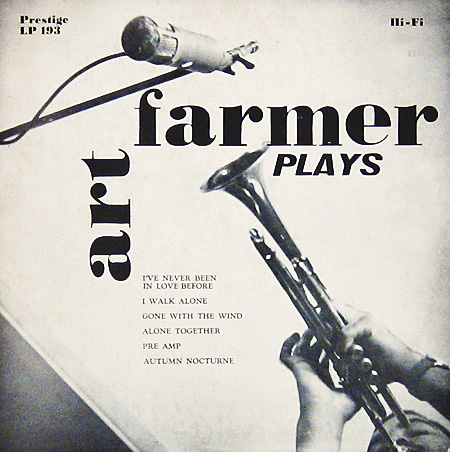 Art Farmer had a long, distinguished and varied career -- so much so
that these sessions on Prestige have recently been reissued under the
quasi-dismissive title Early Art. And it's certain that a great career was still ahead of Art. He would co-lead the legendary Jazztet with Benny Golson from 1959-62. He would be the first to popularize the flugelhorn as a jazz instrument, and introduce a new instrument: the flumpet, about which he has said:
Art Farmer had a long, distinguished and varied career -- so much so
that these sessions on Prestige have recently been reissued under the
quasi-dismissive title Early Art. And it's certain that a great career was still ahead of Art. He would co-lead the legendary Jazztet with Benny Golson from 1959-62. He would be the first to popularize the flugelhorn as a jazz instrument, and introduce a new instrument: the flumpet, about which he has said:I hate that name, but I’m stuck with it. That was made by a trumpet-maker named David Monette, who makes trumpets for a lot of very fine trumpet players, such as Wynton Marsalis, for instance, and the principal players for the Boston Symphony and the Chicago Symphony and the Chicago Symphony, etcetera. I asked him to make me a trumpet, and he made it, it was very fine, and I started really working on the trumpet. Then he got the idea that it didn’t really sound like me, but he wanted to make a flugelhorn for me — so I told him to go ahead and do it. Then he called up one day, and he said, “Well, I made it very carefully and put every part in order, made it by hand [because everything is made by hand], but it sounds like hell, and I really don’t like it. But I have another idea.” So I told him to go ahead and make it. Then a couple of months later, he called and said, “it’s ready.” I went to Chicago, where I was booked, and he brought it on the gig — and right from the start, it sounded like the answer to my prayers...you could go one way or the other on it. You could approximate the warmth of the flugelhorn or you could approximate the projection of the trumpet. If you really wanted to put a note out there, you could do it, and if you wanted to be more intimate, you could do that also. So it seemed like what I was looking for.He would play in a wide variety of settings, from Charles Mingus to Horace Silver to Gerry Mulligan, from the big bands of Quincy Jones, Oliver Nelson and George Russell, to sessions with the French composer Edgar Varèse, because of his reputation as a guy who could play anything.
But he was already that guy when he was still Early Art, in 1954. He had started out in high school in LA with schoolmates Hampton Hawes, Sonny Criss, Ernie Andrews, Big Jay McNeely, and Ed Thigpen.* He had played rhythm and blues with Johnny Otis, Kansas City swing with Jay McShann and blues with Big Joe Turner and Pete Johnson (his first recording session), and the intergenerational, genre-defying jazz of Benny Carter, before his breakthrough 1952 session with Wardell Gray, the one that introduced "Farmer's Market." He had been part of the Lionel Hampton European tour that brought so many young musicians together.
And the same is true of Wynton Kelly. He's probably best known for his work with Miles Davis (including one track on Kind of Blue) during the same time period that Farmer was with the Jazztet. But Kelly had been playing since his early teens, and had actually been part of a Number One rhythm and blues hit in 1948 -- Hal Singer's "Cornbread."
Addison Farmer, Art's twin, also started young out on the West Coast, playing the house band of the R&B label Modern, and recording a bebop session with Teddy Edwards. When he and Art hooked up for this session, he had taken up residence in New York and studied at Juilliard and the Manhattan School of Music, as well as taking private lessons from New York Philharmonic double bassist Fred Zimmerman.
This session features a lot of standards, though if the definition of a standard is one where everyone knows the melody and can sing along at least a couple of choruses, most of these barely qualify. The one solid classic is Frank Loesser's "I've Never Been in Love Before," from Guys and Dolls, to my mind the greatest musical score ever. Farmer and Kelly take it at a brisker tempo than the many ballad singers who've done it, but they still keep it a ballad, and beautiful.
But the others have attracted jazz musicians before and since -- Charlie Parker recorded "I'll Walk
 Alone," Chet Baker and Paul Desmond have each done "Alone Together," and "Autumn Nocturne," by film score composer, has become something of a jazz standard.
Alone," Chet Baker and Paul Desmond have each done "Alone Together," and "Autumn Nocturne," by film score composer, has become something of a jazz standard.All of them, and the one original, "Preamp," give much to love, and give plenty of reasons why this is more than "early Art," or early Wynton, for that matter.
"I'll Walk Alone"/"Autumn Nocturne" were released on 78. The session came out on a 10-inch LP in 1955, and then not again ill the reissue days many years later.
* Funny, that's two straight blog entries, two opposite coasts, two guys right around the same time hanging out with a bunch of kids who would go on to become giants of jazz. In the Monk/Rollins entry we saw the young Art Taylor with Sonny Rollins, Jackie McLean, Kenny Drew and Andy Kirk Jr.


No comments:
Post a Comment